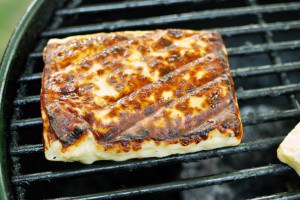
Of course a cheese’s personality is largely dependent on the taste, texture, aroma, and ingredients that go into it, but there are other parts of a cheese’s story that contribute to its character. In this blog series, Natalie investigates the distinct personality traits of some of the most unique cheeses out there.
It looks a little like bread, a little like cooked tofu, and a little like the top of a burnt lasagna. It’s sometimes called “Finnish Squeaky Cheese.” But it’s most often referred to as Juustoleipä.
Juustoleipä (hoo-sta-lee-pah), or Leipäjuusto, is Finnish for “bread cheese.” In Finland, the cheese was originally made from reindeer’s milk, and is easily recognizable by its browned, loaf-like appearance.
It’s not a hard cheese to make, but the end result is unique. Rennet is added to milk to form cheese curds, which are then pressed into a pan (traditionally in a disk shape). The curds are then baked, toasted, or grilled to create the trademark toasty spots on the outside of the “loaf.” The result is a buttery, fresh cheese with a slightly sweet, caramelized outer crust.
This mild-flavored cheese is very versatile and can be served warm or cold. Most fans prefer their bread cheese served warm, though. One of the qualities of this cheese that makes it popular is its grill-ability. It’s one of few grillable cheeses (halloumi is another), which are a bit perplexing at first because, interestingly, they don’t melt—and we expect cheese to melt. When re-heated, this cheese actually stays in one piece but gets creamy and near-melted on the inside, creating a veritable bread-less grilled cheese.
Though heat doesn’t melt the cheese, it does change its consistency significantly. Cold Juustoleipä is springy and grainy in texture while warm Juustoleipä is silky and smooth with just a little snap to it.
So why doesn’t it melt? Many factors contribute to the melt-ability of cheese, including moisture, fat, salt, age, and acidity. In a general way, these chemical components affect how protein breaks down, which is essentially what the process of melting cheese is. Sid Cook of Carr Valley Cheese, who makes a version of Juustoleipä, explains that in this case, the cheese doesn’t melt because it has a low acid content. This cheese is low in acidity due to the fact that it does not have cultures (the bacteria that develop cheese into a certain style) added to it.
American cheesemakers have developed variations of this baked cheese, made with cow’s milk. The American versions are often sold under the shortened name of “Juusto” or “Bread Cheese.” Carr Valley’s Bread Cheese, for example, is pasteurized to lengthen shelf life and make the cheese safer for consumption, but it retains the baked loaf qualities of the traditional kind.
In the summertime, throw Juustoleipä on the grill until it gets just gooey and smokey enough, then enjoy as-is. Chop it into bite-size pieces and drizzle with honey, or serve cold with fruit, jam, or nuts. Or, go the traditional Finnish way and dip it into a nice cup of coffee to switch up breakfast time.
Be sure to read my next blog post on the personality of washed rind cheeses.
Featured image from Me Hungry blog







This cheese tastes great with honey or jam. I added it to my breakfast rotation. I usually buy mine from https://www.gourmet-food.com/cheese/bread-cheese-juustoleipa-102763.aspx.
Personally I think Juustoleipä is best with some cloudberry jam (“lakkahillo”). Beside eating it as it is topping juustoleipä with cloudberry jam is the most common way people eat it in Finland.